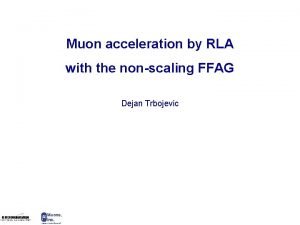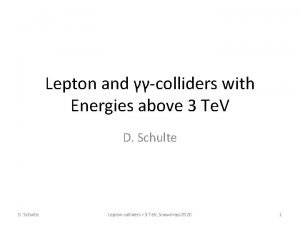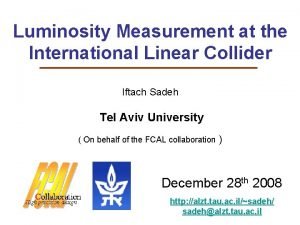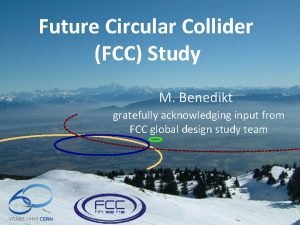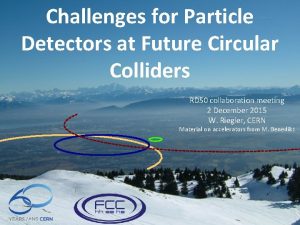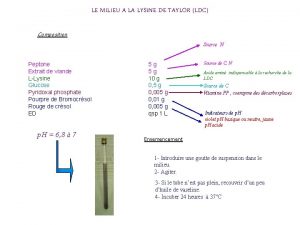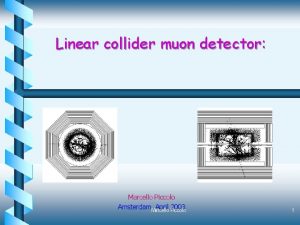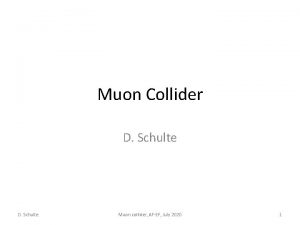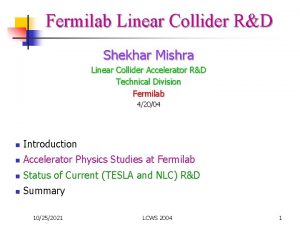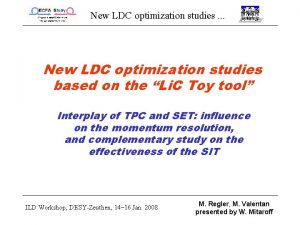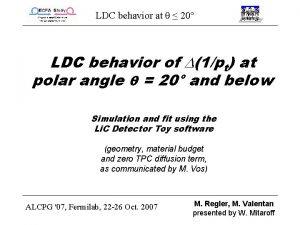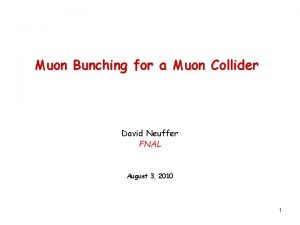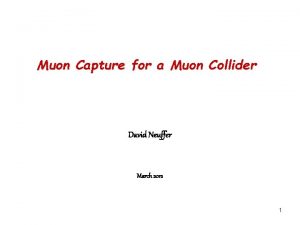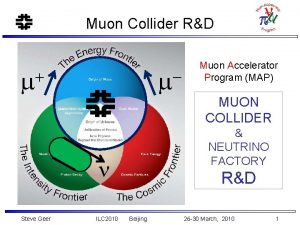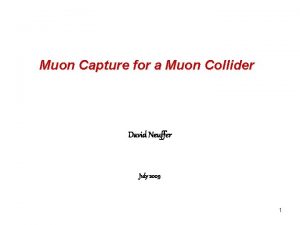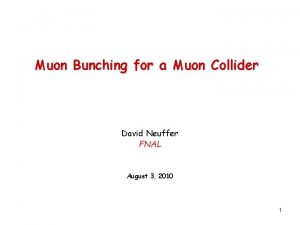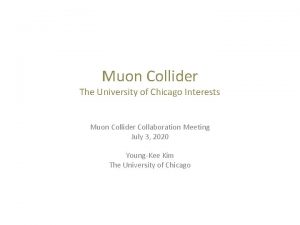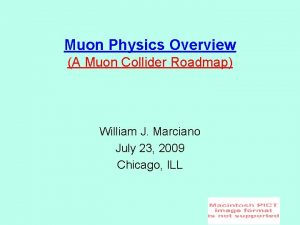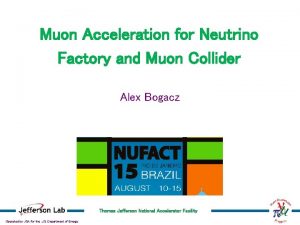Linear collider muon detector the LDC design Marcello






















- Slides: 22

Linear collider muon detector: the LDC design Marcello Piccolo , Vienna Nov. 2005 Marcello Piccolo 1

Agenda • Few words on the task of the m system • m-identification and energy leakage measurements. • • • Implementation The TESLA-TDR design Performances • Identification • Energy measurement • Conclusions Marcello Piccolo 2

What do leptons buy for us • Identifying leptons has obvious advantages in sorting out events characteristics: • e. g. direct identification of the W charge • direct fermion/antifermion type identification • direct flavor identification • It can help out on the instrumental side too: • Semileptonic decays imply neutrino’s presence, hence energy missing. Marcello Piccolo 3

Electrons vs. muons Both electrons and muons are identified calorimetrically: Electrons on radiation length scale Muons on interaction length scale identification based on lack of interaction energy loss just for ionization need to follow the non-interacting candidate after a substantial # of interaction lengths. No need to measure momentum. Track association is good enough to guarantee matching between TPC and muon detector. Marcello Piccolo 4

Design feature • Muon detectors are then bound to be at the biggest radius ( need to integrate many l ) • Big radial distances also mean high momentum threshold need a backup system for low momentum tracks. • Low momentum identification difficult: • • p and m look alike many more p at low momenta. Marcello Piccolo 5

Know your friend and foe • Here is the momentum spectrum for PRIMARY particles coming from the STANDARD MODEL MIX. • In black the hadrons • m have the red error bar • Overall we have in 4000 evt’s 952 m’s and 51, 000 hadrons. Marcello Piccolo 6

Single particle studies • Try to use simple events to design the hardware. • Check afterward that more complicate events do not cause derated performances. • Functionalities needed: • Muon id. • Measure energy leaking out of the coil. • Simulation used: Brahms with the TDR default options. Marcello Piccolo 8

Identification algorithm • As mentioned before the method is (on purpose) very naïve. • Loop on all the hits in the first plane of the m-system and try to build a stub of hits that extends in depth, matching the q and f of the hits in the other active planes of the detector • Define as a m-candidate a stub that is more then xx planes deep. • Match the stub with one extrapolated track in the central tracker. (q and f at the first plane) Marcello Piccolo 9

Single particle studies • Generated 10, 000 single p with flat momentum and angle distributions. • Looked at misid. probabilities and energy leakage. • Used as a baseline detector the TESLA-TDR muon system. • The system consists of 12 active detector planes in the barrel, 11 in the end caps. Longitudinal segmentation 10 cm Fe 11/10 (barr/e. c). times +1 plane after 50 cm. (total thickness 1. 5 m Fe fixed by flux return considerations. • Realistic efficiencies put in by hand. Marcello Piccolo 10

p Misidentification vs. thickness Marcello Piccolo 11

Energy leakage single p Marcello Piccolo 12

Energy leakage Standard Model Mix • 81% of the events cause (non-m) hits in the muon system. • 9. 5% of the events drop more than 1 Ge. V in the muon system Marcello Piccolo 13

Misidentification Standard Model Mix Marcello Piccolo 14

What about efficiency ? • • Single m detection efficiency vs. momentum Requiring xx planes for the stub Marcello Piccolo 15

What about efficiency ? • • Single m detection efficiency vs. azimuth Requiring xx planes for the stub Marcello Piccolo 16

What about efficiency ? • • Single m detection efficiency vs. polar angle Requiring xx planes for the stub Marcello Piccolo 17

What about efficiency ? • Standard Model m detection efficiency vs. momentum Marcello Piccolo 18

Requirements on spatial resolution q and f r. m. s. at the first detector plane. The distribution width sets the spatial resolution scale for the detectors: working out the figures one gets 1. 5 -2. 0 cm. Marcello Piccolo 19

Few words about low momenta • Given the B-field and the radius of the system it is impossible to detect m below 5 Ge. V/c. • Using the Had cal one might be able to alieviate the problem. • However in ZZ/Zg/WW events the background is prohibitive. Marcello Piccolo 20

Few words about low momenta (cont. ) Fake and true ratios for muons m-system m-analysis Fake and true ratios for muon Had. Cal SNARK Marcello Piccolo 21

How do we break it down • • • Barrel: way to big to make it on piece. Break it in three pieces so minimizing transition region by slanting. If the barrel has to be long, then insert the endcaps in. • • Marcello Piccolo The aspect ratio for the end-caps less favorable Detectors shape more complicated, so better if smaller…. . 22

Conclusions • The m-system design from the TESLA-TDR seems to cope with the anticipated Physics program for the ILC. • Muon detection efficiency and background contamination seem to be under control. • Low energy m’s could be detected: what needs to be looked at, is the Physics background from gg events: we need a complete simulation for these events (gg mm) • Energy leakage behind the coil, seems to be not very important; it can, however, be measured to a meaningful level. Marcello Piccolo 23
 Muon collider
Muon collider Muon collider
Muon collider Muon detector
Muon detector International linear collider
International linear collider Fcc collider
Fcc collider Fcc collider
Fcc collider Language
Language Unity sphere collider
Unity sphere collider Hadron collider
Hadron collider Hadron collider
Hadron collider Cern future circular collider
Cern future circular collider Mdc and ldc
Mdc and ldc Is pastoral nomadism ldc or mdc
Is pastoral nomadism ldc or mdc Lund uni webmail
Lund uni webmail Difference between mdc and ldc
Difference between mdc and ldc Ldc meaning
Ldc meaning Ldc core tools
Ldc core tools Ldc core tools
Ldc core tools Webmail.lu.se
Webmail.lu.se Literacy design collaborative
Literacy design collaborative Milieu ldc
Milieu ldc Gcu ldc appointment
Gcu ldc appointment Gender empowerment measure
Gender empowerment measure
